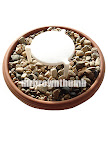
If you have an Amaryllis you can easily hack it to produce seeds which you can then sow and produce even more plants that you can share with others, keep for yourself or sell.
Look at the image on the right. The stamen is the slender white stalk that's holding up the anther. The anther is the sack that holds the pollen. These are considered the male parts of a flower. This usually matures before the stigma.
The stigma is on the left and it is the tip of the female reproductive parts of the flower. Notice how the ends are curled back, this occurs a couple of days after the flower has opened and is ready to be pollinated.
If you want to propagate your Amaryllis it's really very easy. Cut the white slender stalk that's holding up the anther and tap it onto the stigma when it look similar to the stigma in the image above. If that seems too difficult then just take a small artist's paint brush and rub it up and down on the pollen. Now look at your paint brush and you should see there is a yellow dust like substance. Now take your paint brush and "paint" the tip of the stigma with the pollen you picked up on the brush.
Your flower soon will start to die because it has lived and completed it's purpose. Which was to attract a pollinator, which in this case was you. Leave the flower alone and let it die on it's own terms. If you were successful after a few days you should notice the swelling of the seed pod right behind the dying flower. Leave everything alone and about 5-6 weeks later your seeds should be ready. You'll notice the seed part start to split open and inside you'll find a lot of black paper thin seeds. Don't let them fool you those are the seeds and you want to sow those soon.
Do you have more than one Amaryllis? Are they blooming at the same time? Take the pollen from one plant and place it on the stigma of the other. It's a good way of making crosses of your Amaryllis bulbs. Your seedlings should be old enough to bloom by their third year.
If you start your seeds in soil using something like the Ghetto Greenhouse stand the seeds on their sides, or you can start them using the Baggie Method. I'll post photos soon of what my seedlings look like. When I do at the bottom of this post you should see "Links to this post" to help you keep track of them.
*edit*
On Sunday March 25th my first seed pod opened. I'll post pictures soon.
UPDATE:
I started www.AmaryllisBulbs.org a blog devoted to growing Amaryllis bulbs and various tips. If you want to know what to do after the seed pods form check it out.
Here's a video I made showing you how to pot an Amaryllis Bulb.
and one showing you how to pollinate an Amaryllis flower.








